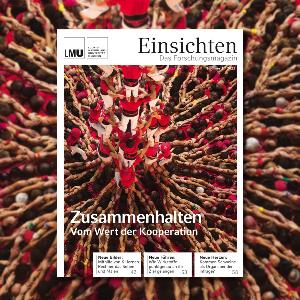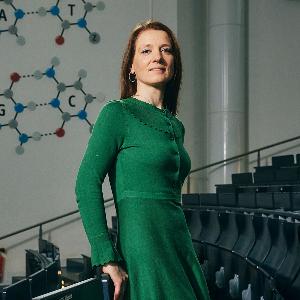A matter of perseverance
4 Sept 2023
Since the start of her career, Olivia Merkel has been researching methods for transporting therapeutic RNA segments precisely to their target location in the lungs. A portrait from our science magazine EINSICHTEN
4 Sept 2023
Since the start of her career, Olivia Merkel has been researching methods for transporting therapeutic RNA segments precisely to their target location in the lungs. A portrait from our science magazine EINSICHTEN
Breathe in, breathe out. So far, so normal. Every one of us does this approximately 23,000 times per day. With each breath, roughly two to three liters of air flow into our lungs through the bronchi and make their way into the tiniest of alveoli. By this process, the organ comes into constant contact with pathogens, chemicals, and pollutants from the ambient air. It is not surprising, then, that the disease burden of respiratory illnesses is so high.
Over a billion people worldwide suffer from acute or chronic respiratory diseases such as asthma, chronic obstructive pulmonary disease (COPD), cystic fibrosis, and lung cancer. Since the beginning of the pandemic, moreover, the number of pulmonary function disorders has substantially increased. New therapies are urgently needed, ideally non-invasive treatments without side effects. The big advantage of the lungs is that drugs can be inhaled and thus delivered directly to their site of action, without having to take a detour through the bloodstream.

Read the latest findings on holding things together in the current issue of our research magazine EINSICHTEN at www.lmu.de/einsichten | © LMU
This is precisely the research pursued by Olivia Merkel, Professor of Drug Delivery in the Department of Pharmacy at LMU. It is her goal to develop novel nano delivery systems for drugs against lung diseases.
Merkel has been researching gene delivery for the past twenty years. In a nutshell, gene delivery is about figuring out the most effective way of carrying genes, or at least short fragments of genetic material, that can function as a drug, to their site of action – that is to say, into the diseased cells. “For a long time, people regarded my work as too remote from clinical translation,” she recalls. Acquiring funding required a lot of stamina. “Today, the topic is experiencing a veritable boom – not least because the mRNA vaccines against Covid-19 are also based on this principle.”
These swings in enthusiasm are indicative of how strongly interest in gene delivery has fluctuated over time. When the complete human genome was decoded in April 2003, for example, Olivia Merkel was still studying pharmacy in Marburg. At the time, gene delivery was a hot topic at universities, private research institutes, and in industry. “People thought back then that every disease would become curable,” Merkel remembers.
The basic concept is quickly explained: Numerous diseases are caused by mutations in certain genes. If we could silence these mutated genes, then the disease would be cured. To do this, we could introduce short interfering RNAs (siRNAs) into the cells, which prevent the gene in question from being translated into a protein and thus from causing damage. There are also several immediate advantages to administering drugs directly to the target location as opposed to, say, injecting them: the required dosage is lower, there are fewer side effects, and systemic effects can be avoided.
Today, the topic of RNA delivery is experiencing a veritable boom – not least because the mRNA vaccines against Covid-19 are also based on this principle.Prof. Olivia Merkel
Merkel is fascinated by this idea and its possibilities. But the first time she entered “siRNA delivery” into the search box of a major database of all published journal articles in biomedicine, she got a paltry 12 hits. “There was just very little research in this field at the time,” explains Merkel. Quick success proved elusive in the first instance. The first (and to date one of only five) approved siRNA drug took 16 years to develop and consumed 2.5 billion US dollars. After a few years, many companies threw in the towel, research projects were dropped, and scientists went scouting for other topics to research. “I did not allow myself to be deterred and just kept going,” says Olivia Merkel with a smile.
Certainly, there was no shortage of problems for her to overcome. So that the siRNAs can silence such pathogenic genes, they must first be delivered into the diseased cells. This is particularly easy with the liver, as everything absorbed by the body ends up in this detoxification organ. It is no coincidence, then, that all siRNA drugs approved to date have the liver as their target. “I found that focus too narrow and so I quickly concentrated on the lungs instead,” explains Merkel.
After all, lung cells are relatively easy to access for drugs in principle thanks to their huge collective surface area of around 100 square meters. However, pure siRNAs cannot bind to the cells or even be taken up by them. To this end, they have to be embedded in other materials first. This packaging of lipids, polymers, and other molecules forms nanoparticles, which can be actively taken up by the cells by means of endocytosis. The optimization of this packaging – effectively the construction of a particularly efficient drug shuttle – is at the core of Olivia Merkel’s work.
When the siRNA nanoparticles have been taken up by the cells, they are trapped initially in the so-called endosome, surrounded by a stable, impermeable membrane. The cell recognizes the nanoparticles as foreign substances and has no warm welcome in store for them, but plans to have them removed by its internal garbage disposal machinery. To prevent this from happening, the nanoparticles must possess a component that helps them exit the endosome again. Only then can they access the cytoplasm, where they can become active and do their healing work.
Merkel researched how siRNAs could be successfully introduced into the T cells of the immune system, which are overactive, for example, in the lungs of asthma sufferers. And in fact she found a novel means of smuggling in the drugs, so to speak: a receptor that normally transports iron to cells is also able to introduce siRNA nanoparticles into T cells. Helpfully, activated T cells produce more of these receptors than naïve ones. So it is possible to spare the naïve T cells and do without general immunosuppression. The therapy is highly specific, and systemic side effects, such as a complete downregulation of the immune system, are avoided.
With these promising results in her hand luggage, she moved to Detroit and researched as a tenure-track professor at Wayne State University. These would prove to be the hardest years of her career. The battle for funding in the United States is merciless to this day. She was competing against research groups that were much larger and better known than her own and kept on going away empty-handed. “That was a long period of drought,” recalls Merkel. “But I’m glad that I always remained so stubborn.”
Rather than change her research field, she chose to move country again. While the Americans had a skeptical attitude toward her work, Europe signaled its[OM1] interest. The young pharmacist managed to land a coveted ERC Starting Grant for her research idea. With these funds from the European Research Council in the bag, she entered discussions with several European universities – and was welcomed by LMU with open arms. Since then, she has been Professor of Drug Delivery at the Department of Pharmacy, where she has also held a chair since the end of last year.
During the pandemic, she did research on the prevention and treatment of SARS-CoV-2. She was able to demonstrate that siRNA nanoparticles can contribute to slowing virus replication in the lung and alleviating symptoms. However, her primary focus is on the development of a dry-powder platform technology for the targeted delivery of siRNAs to the lungs. She has managed to develop RNA nanocarriers for this purpose, which can be stabilized using a spray-drying technique. This process yields a dry powder that can be kept at room temperature for a long time. She received a smaller Proof of Concept Grant from the ERC last year. This funding is designed to support her in the task of translating her research results into practice. The question she is addressing asks: How can spray-drying be improved such that the dry powder is easier to transport and store under general conditions while maintaining nanoparticle stability?
Aside from issues of shelf life, designing the nanocarriers can be a tricky affair. Before now, the polymer materials for the nanoparticles were synthesized in huge libraries and subsequently tested. “That’s unbelievably laborious and in the end you discover that perhaps only one out of a thousand materials works,” she says, describing a process that is based in large measure on trial and error. She would like to make the development process faster and cheaper. “Because if you already know some criteria that the polymer material is meant to fulfill, such as solubility in water or the size of the particles, then an algorithm could calculate what optimal molecules should look like,” says the pharmacist.
To this end, she combined molecular-dynamic simulations and machine learning methods for the first time. She synthesizes certain polymers, which are loaded with siRNAs and tested and analyzed regarding their suitability and efficacy by means of various methods. Using these results, she wants to develop a model that can predict the suitability of improved polymers as efficient siRNA nanocarriers and thus reduce the time and costs of experiments. Recently, the European Research Council awarded her yet another of its prestigious grants for this project.
She hopes she will be able to start a clinical trial with her novel nanoparticles within the next five years. After all, she feels, it is only when patients benefit from better drugs that her tenacity will have truly paid off.

Olivia Merkel in the lecture hall. | © Florian Generotzky / LMU
Prof. Dr. Olivia Merkel is Chair of Drug Delivery in the Department of Pharmacy at LMU. Born in 1981, Merkel studied pharmacy at the University of Marburg, where also completed a doctorate. She worked as a postdoc in Marburg initially and then moved to Wayne State University in Detroit, Michigan as a tenure-track professor. She has been a professor at LMU since October 2015 and has held a chair since November 2022. In January of this year, the European Research Council awarded her a lucrative Consolidator Grant, the third ERC grant she has received in her career.
Read more articles from the current edition of "EINSICHTEN. Das Forschungsmagazin" in the online section and browse the issue archive.
Or subscribe to EINSICHTEN free of charge and never miss an issue again (in german).